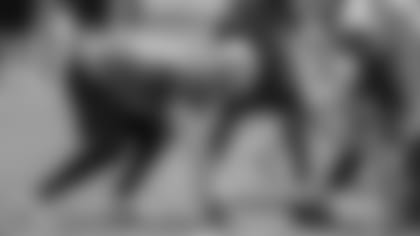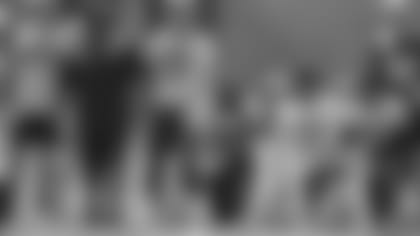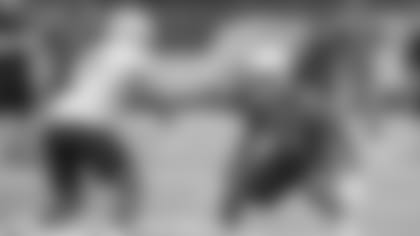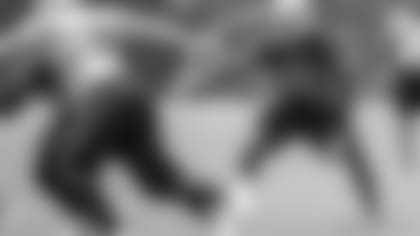From the first pick to the 32nd, the Lions have drafted in almost all of the 32 spots as the current first round of the NFL draft is comprised.
They've hit it big with some picks, with the help of good fortune, while some others failed to pan out.
One example of good fortune: In 2007 the Raiders took quarterback JaMarcus Russell first overall, leaving Calvin Johnson to the Lions with the second pick.
Another example: In 1989 the Packers took offensive tackle Tony Mandarich with the second pick. That left Barry Sanders for the Lions with the third pick.
For the sake of argument and discussion, following is an analysis of which player represents the Lions' best pick from 1-32.
For example, the Lions have drafted three players first overall – Leon Hart (1950), Billy Sims (1980) and Matthew Stafford (2009). Which one was the best pick, and why? Stay tuned.
Some explanations and standards for this exercise:
- The cutoff is 1950.
- Not all 32 players are first-round picks. For example, guard Dick Stanfel, voted into the Pro Football Hall of Fame earlier this month, was drafted 19th overall in the second round in 1951, when the NFL had only 12 teams. In 1950 the Lions had four picks in the top 32.
- The number of first-round picks has grown over the years through expansion, and the merger of the AFL and NFL that resulted in the first combined 26-team draft in 1967.
The NFL didn't have 32 teams until 2002, when the Houston Texans entered the league as an expansion franchise.
- In some cases, only one player ever was picked in one spot. Obviously, the player in that spot wins by default.
- The Lions have not drafted in all 32 spots. For example, since 1950 they have not had the fourth or 14th picks.
The first installment of this has picks 1-16. Picks 17-32 appears later this week.
As always feel free to disagree.
1. Top contenders: Leon Hart 1950; RB Billy Sims 1980; QB Matthew Stafford 2009.
Pick: A tougher call than some might think, and it comes down to a choice between a great runner of the past and a quarterback of the present and future.
Leon Hart played offense and defense in an eight-year career and was a key player on two championship teams.
Billy Sims' career ended midway through his fifth season with a knee injury in Game 8 of 1984 – with 22 carries for 103 yards – and he was a star from first carry to last.
If longevity is a factor, Stafford has settled the Lions' quarterback situation for seven years, and he has more good years ahead of him.
For short-term impact, Billy Sims comes out ahead. He was the primary reason the Lions rebounded from 2-14 in 1979 to 9-7 in 1980 in his rookie year. However, if Stafford remains on his current track, this could change in a couple years.
2. Top contenders: WR Calvin Johnson 2007; DT Ndamukong Suh 2010.
Pick: Calvin Johnson, in a choice between the dominant wide receiver and the dominant defensive lineman.
Johnson has given the Lions nine years. Suh gave them five before leveraging his way out of town.
Other of note: Wide receiver Charles Rogers was drafted second overall out of Michigan State in 2003. After broken collarbones ended his first two seasons, his career deteriorated because of personal problems off the field. 3. Top contenders:DB Johnny Robinson 1960; S Bennie Blades 1988; RB Barry Sanders 1989.
Pick: Barry Sanders. It's a no-brainer. The Hall of Famer was the most electric runner of all time.
Blades was a Pro Bowl safety and the enforcer and leader of the secondary.
Robinson, drafted in 1960, had 57 career interceptions -- but never played for the Lions. He signed with the AFL, but he was a terrific draft pick.
Other of a sour note: Joey Harrington, drafted in 2002, is not a contender. He endured a four-year torture test in Detroit as an unpopular player with fans and teammates. 4. No pick at No. 4.
5. Top contenders: CB Bryant Westbrook 1997; DE Ziggy Ansah 2013.
Pick: Ziggy Ansah. His speed, power and relentless drive make him a force coming off the edge. He made his first Pro Bowl in 2015 with 14.5 sacks, and there is more to come from this young star. Westbrook had a decent career, but it ended early because of an Achilles injury.
6. Top contenders: FB Nick Pietrosante 1959; OT Lomas Brown 1985.
Pick: Lomas Brown. He played 18 seasons, the first 11 with the Lions, and made seven Pro Bowls. He started 251 games, tied for ninth all-time, and was one of the best pass-protectors of his era.
Pietrosante was a tough inside runner and blocker who rushed for 4,026 yards and 28 TDs in nine seasons, but Brown's career was longer and superior.
7. Top contenders: RB Mel Farr 1967; WR Roy Williams 2004.
Pick: Mel Farr. He was offensive rookie of the year, and he gave the offense production when healthy. He scored 36 career TDs.
Extra credit: Along with teammate Lem Barney, Farr once sang backup for Motown legend Marvin Gaye.
Historical note: Williams made one Pro Bowl in four full seasons as a Lion before being traded to Dallas, but his lasting contribution was giving Calvin Johnson the nickname "Megatron."
Failed picks: DE Reggie Rogers (1987) had problems on and off the field and was one of the biggest draft failures in franchise history.
Behavior was not an issue for QB Andre Ware, drafted in 1990. He started six games in four years and was out of football after 1993.
8. Only contender: LB Ed O'Neil 1974.
O'Neil was serviceable in six seasons as a Lion, four of them as a starter. A shoulder injury reduced his effectiveness.
Second-guessing: The Lions passed on taking LB Randy Gradishar instead of O'Neil because of injury concerns. Gradishar was the next linebacker off the board at No. 14 to Denver, where he played 10 seasons, made seven Pro Bowls and missed only eight games in his career.
9. Top contenders: LB Ernie Sims 2006; LB Chris Claiborne 1999.
Pick: Make it a tie – and not exactly a choice between Dick Butkus and Joe Schmidt.
Sims was a high-effort outside linebacker who fit first-year head coach Rod Marinellii's scheme, but he was under-sized and ultimately injury prone. He was gone after four seasons. Claiborne was a hitter in the middle, but with limited range. Like Sims, he was gone from Detroit after four seasons.
10. Top contenders: WR Herman Moore 1991; DL Alex Karras 1958.
Pick: A close call – closer than old-time Lions fans might like.
Moore and Karras both were four-time Pro Bowlers and three times first-team All-Pro. Moore won two receiving titles and set the single-season record for receptions with 123 in 1995. It has since been broken. There are many who think Karras was a Hall of Fame snub. He dominated the interior with quickness.
Having watched Herman Moore's entire career, it's hard for me to pick against him considering the receiving stats he compiled in an offense with Barry Sanders as the No. 1 option.
That makes Moore the pick.
Note: John Hadl, who signed with the AFL, Keith Dorney, James Hunter and Eric Ebron were others drafted at No. 10.
A certified bust at No. 10: Mike Williams in 2005. He was traded away after two seasons.
11. Top contenders: FB Tom Nowatzke 1965; QB Greg Landry 1968; CB Luther Bradley 1978.
Pick: Greg Landry, for longevity and production.
Landry played 15 NFL seasons over 18 years (1968-84) and spent the first 11 seasons with the Lions. He led them to the 1970 playoffs as a wild card and made a Pro Bowl. Landry and Stafford are the only quarterbacks to make the Pro Bowl as Lions since Bobby Layne.
The best of Nowatzke's five seasons as a Lion was 1966, when he scored six TDs rushing and receiving combined. He finished his eight-year career in Baltimore, where he played on a Super Bowl champion.
Bradley played four seasons as a Lion, but his most memorable moment came in the old USFL, when he intercepted six passes in a game.
12. Top contenders: DE Bill Glass 1957; OT Daryl Sanders 1963; QB Chuck Long 1986.
Pick: Bill Glass, but not just for what he did in Detroit. Glass was a four-time Pro Bowler, but that came in Cleveland, after he was traded for Milt Plum after four seasons in Detroit. He was a quality draft pick, and the Browns benefited most.
Long had the makings of a solid game manager, but he threw out his arm in training camp in 1988 and was never effective after that. Sanders retired to go into business after starting every game for four seasons.
Dave Middleton (1955), caught 17 passes in seven seasons and played on the 1957 championship team before retiring to become a doctor.
13. Top contenders: G Harley Sewell 1953; FB James Jones 1983; DT Nick Fairley 2011.
Pick: Harley Sewell, with Jones a close second. Sewell made four Pro Bowls and played on the 1953 and '57 championship teams.
Fairley never lived up to his athletic potential in four seasons as a Lion. Jones was a polished all-around runner, blocker and receiver who scored 36 career touchdowns and threw a TD pass. 14.No pick at No. 14.
15. Only pick: LB Jimmy Williams 1982.
Williams was a tough, all-around linebacker who defended the run and the pass. He might have made a Pro Bowl had he played on winning teams. Williams played 12 seasons, the first nine as a Lion, and had 13 interceptions, 27.5 sacks and played 153 games.
16. Top contenders: DT Herb Orvis 1972; RB Lawrence Gaines 1976; WR Mark Nichols 1981.
Pick: Herb Orvis. He came to the Lions as a 26-year-old rookie who played with high intensity. He played six seasons in Detroit and the last four in Baltimore, where he was a full-time starter his last season at the age of 35.
Nichols had size and speed but never put it together. Gaines would have been a Pro Bowl power back, but a knee injury late in his rookie season shortened his career and limited his effectiveness when still active.
Next: 17-32













